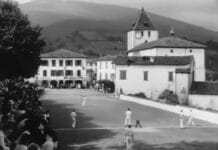This post could have also been entitled: Maurice Ravel: the Basque composer who believed in his country
Maurice Ravel, one of the greatest composers of the extraordinarily creative period spanning from the last decades of the XIXth century to the beginning of Second World War, was born on March 7, 1875 in Ciboure (Lapurdi).
He is a first-class example for those who love classical music as well as for ordinary people, mainly due to his “Bolero”, which turned into a key piece of the soundtrack of many films since 1936 (including the Japanese Rashōmon, considered Akira Kurosawa’s masterpiece and released in 1950); and inspired hugely successful songs, such as Gilbert Bécaud’s Et maintenant, which was written in 1961.
In other words, he was a universally acclaimed and renowned musician. However, we are sure that if we asked around the streets of any Basque town who the greatest Basque composers are, very few passers-by would mention Maurice Ravel (with the possible exception of some areas in Iparralde).
Sadly, it’s also true that many of us wouldn’t be able to mention four Basque composers, which makes it clear that, as a society, we suffer from a deep lack of knowledge about our history and culture.
In any case, going back to Ravel: the coincidence in time of the post we have written about the exhibition “Hidden in Plain Sight: the Basques” in the Sparks Museum of Nevada and the anniversary of the birth of this composer has convinced us of writing this entry to remember this date and to reclaim his “Basqueness”.
For that purpose, we are hereby going to recall what we wrote in two previous entries about this composer.
We live accepting that Basque nationality remains diluted in the Spanish and French statehoods. As we have said in many occasions, when the downsides of the Basque Country are discussed, such as terrorist attacks, they are always attributed to the Basque people (Basque terrorists); however, when talking about positive achievements (such as those in the fields of culture, research, economy or business activity), these are attributed to Spaniards or the French.
Ravel’s case is paradigmatic. His biographies remind us of the entry in a French encyclopedia which stated that Picasso was a French artist born in Málaga. Something similar happens in the case of the Basque composer. We find references to him as a French composer all around, whilst his Basque origin and the Basque culture’s influence upon his work are ignored, concealed or downplayed. All this in spite of the fact that he was Basque, spoke the Basque language (artist José Mari Uzelai from Bermeo met him in Paris and spoke with him in Basque), was deeply influenced by Basque culture and music, and harboured a Basque national sentiment he projected onto his unfinished and almost unknown work, about which we wrote in our website a while ago. (A blog entry of which we hereby include some extracts but which we sincerely believe to be a must-read).
Little has been discussed about this unfinished project, a great piece entitled Zazpiak Bat (the seven are one) dedicated to the Basque people, which he abandoned in the beginning of First World War. Nevertheless, this work made a lasting impact on other masterpieces of the composer, such as his Trio for piano, violin and violoncello, in which we encounter many influences of traditional Basque music.
It is worth remembering that the Zazpiak Bat coat of arms and motto was created at the end of the XIXth century to reclaim the unity of all seven Basque territories. It was created in the continental Basque Country (better known as the French Basque Country) in 1897, when Ravel was 22 years old, and reflects a broad-based social and political movement which seeked to recover the Basque rights and freedoms, which were lost with the French Revolution in the northern part of our country and the Carlist Wars in the south.
From our viewpoint, when choosing this title for his work, the composer did not only intend to play a tribute to his motherland. The title of any artwork strives to represent its very own essence, so using the Zazpiak Bat term and idea, went much further than simply honouring a remote corner of France. It wanted to reflect the existence of a national reality that goes beyond state limits and that brings together the Basques to the north and south of the Pyrenees.
His own sense of belonging to the Basque nation was also evident from his friendship with Aita Donostia, as pianist and researcher Josu Okiñena narrates:
when he met the Donostia-born priest, in 1920, “he was afraid to encounter a very monastic music, but he was pleasantly surprised by the work’s music sensitivity”. So much that he wrote to his mentor, Eugène Cools, to reccommend him. “A countryman of mine, for you should know that us Basques have two homelands, Aita Donostia, has visited me to introduce his music to me and to ask for my advice…”. “It’s an objective evidence-Okiñena stresses-, we are reading it from primary sources. Not only do we find aspects of Basque music in his work, he himself admits to feeling Basque”. (Noticias de Araba 31/12/2012).
Once again, being only days away from the anniversary of his birth, we want to reclaim this Basque composer. Reclaim him not as a composer, as he is already universally acclaimed, but as a Basque, a key element of his life and work that not even Basques know, since it has been hidden from us.
Us Basques live hidden from everyone’s views. We even live hidden from ourselves.
We leave a video of his Trio for piano, violin and violoncello, in which we find great influences of traditional Basque music.
Last Updated on Nov 17, 2021 by About Basque Country






























